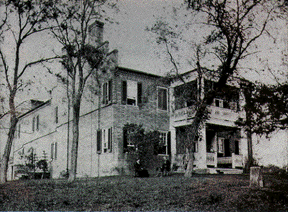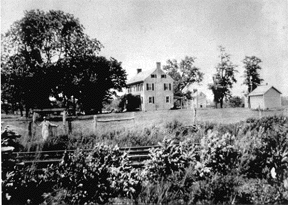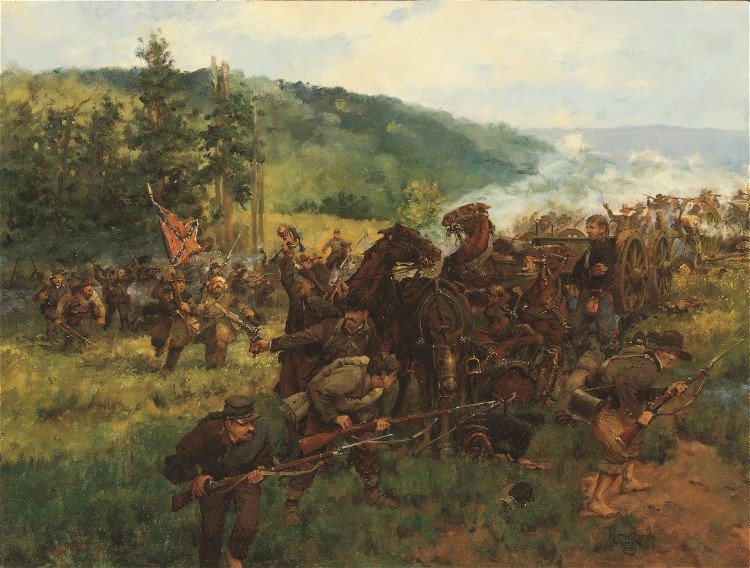
History
A Brief History of Port Republic, VA
At Port Republic, the North River and the South River meet to form the South Fork of the Shenandoah River. When European explorers first entered the area in the early 1700's, it was inhabited by the Shawnee, who came here after battles to refurbish their arsenal as indicated by the large amounts of chopped flint and imperfect arrowheads found here. They took advantage of nature's abundance, lush vegetation, fish and game, provided by the River and its forests.
When the first settlers arrived they were quick to recognize the vast industrial potential of the area, seeing the rivers as a source of power for driving machinery and as waterways for transporting commodities. The first flour mill was built c. 1745 by Captain Henry Downs. In the same time period, the area became home to three influential Virginians: John Madison (Madison Hall), Gabriel Jones (Bogota) and Thomas Lewis (Lynnwood).
Madison Hall
Bogota
Lynwood (still standing)
In 1802, the village was chartered as a town by an Act of the General Assembly. It was laid off into lots and streets on the land of John Carthrea, Jr. and its size was nearly doubled immediately by the "Carthrea addition" of land of John Carthrea, Sr. The growth and prosperity was such that the next year the town of New Haven (now nearly non-existent) was established on the North River bank opposite Port.
A model of the 1776 gundalow, USS Philidelphia
In 1784, George Washington, while visiting at the home of Gabriel Jones, had written in his diary about the possible navigability of the South Fork of the Shenandoah to its confluence with the Potomac. In 1814, the New Shenandoah Company was established by Act of the General Assembly (through efforts headed by Stephen Harnsberger) to make the river navigable for flat-bottomed boats. These were called "gundalows," as long as 90 feet. Commodities were brought in from nearby farms, industries, and mines on the eight public roads which led to Port, and were shipped to Harper's Ferry. Boating became a major industry which endured more than a half century.
The Battle of Port Republic
June 9, 1862
“They poured a volley into our ranks when we without delay returned the compliment…Here was the place to try men’s [souls].”
The Battle of Port Republic was a ferocious, hard-fought victory that brought a triumphant end to Stonewall Jackson's famed Valley Campaign, freeing his army to leave the Valley and aid Robert E. Lee in the defense of Richmond.
Prelude to Port Republic
Late in the 1862 Valley Campaign, Gen. Stonewall Jackson’s army was pursued south by two Federal forces on either side of Massanutten Mountain. Reaching the mountain’s southern tip, Jackson stopped to face his pursuers. On June 8, Confederate troops under Gen. Richard S. Ewell defeated Union Gen. John C. Frémont at Cross Keys. The next day, Jackson turned towards the other Federal force east of Port Republic.
Confederate Maj. Chatham Roberdeau Wheat, commander of the Louisiana Tigers
The Battle
Having successfully held off Fremont, Jackson quickly turned his attention to Shield’s smaller force. Joined by Ewell, Jackson’s plan was to concentrate his army against Shields and quickly crush him with overwhelming numbers. The logistics of moving most of his men from Cross Keys to, and then beyond, Port Republic, proved more difficult than Jackson had anticipated. As the action began on the flat plain of the South Fork of the Shenandoah two miles beyond Port Republic, the Confederates were actually outnumbered. The Union’s compact line (commanded by Gen. Erastus Tyler, as Gen. Shields was not on the field) stretched from the river (on its right) to the shoulder of the Blue Ridge (on the left). Artillery occupied this open crest, which dominated the field, known locally as “The Coaling.”
Victory depended on who controlled “The Coaling” and the focus of the battle centered on this open ridge. As his troops trickled onto the field, Jackson sent the majority against this position; with the initial Confederate assaults being repulsed. Eventually, the crack Louisianan brigade of Gen. Richard Taylor swarmed over the Union guns, capturing the position in a vicious hand-to-hand fight.
After failing to re-take “The Coaling” with their own determined counterattacks, the Union troops had no choice but to withdraw. Fremont’s command soon reached the field, but was unable to reinforce Tyler because Ewell had burned all of the bridges spanning the South Fork during his retreat. Although his plan had gone astray, Jackson still managed to win his second battle in two days.
Commanders
Union
Confederate
Casualties
The Origins of the Museum and the Society of the Port Republic Preservationists
In 1976 a group of concerned citizens initiated the Society of Port Republic Preservationists, Inc. (SPRP) to preserve the rich history and unique character of Port Republic, Virginia. SPRP continued its mission by seeking protective legislative decisions, preserving community landmarks, providing educational information, and sponsoring community activities.
After receiving listings for the village with the Virginia Landmarks Commission in 1978, and the National Register of Historic Places in 1981, SPRP began collecting artifacts and oral history with the intention of establishing an interpretive center. In 1992, funds were raised from private sources to purchase the Frank Kemper House (also known as the Turner Ashby House), an historic structure in the village.
Focusing on essential structural repairs and installing temporary exhibits, it was officially opened as the Port Republic Museum in 1993. In 1994, in a cooperative agreement with the American Battlefield Protection Program, SPRP secured an interpretive planner to produce a master plan for renovations and interpretive exhibits, and the initiation of permanent exhibits in the Turner Ashby Room. Since then, the Society continued to restore the house and improve exhibits, often with the assistance of the Shenandoah Valley Battlefields Foundation.
Voices from the Past: Letters and Documents
We hear much about how the Battle of Port Republic and the Civil War affected the village of Port Republic. It is less easy to know how it affected the individuals of Port Republic, both those serving in the military and their families at home.
Among the hundreds of historical documents that are housed in the Port Republic Museum is the following touching note written by Charles Marcellus Kemper, Captain, Co. C, 6th Va. Cavalry, son of Benjamin Franklin Kemper, Sr. (a family living in Port Republic since 1807).
The letter was addressed to John Jacob Nicholas (whose family has resided in Port Republic since the late 1700's). The note refers to two of his three sons in Confederate service, George M. and Silas C.K. Nicholas:
Mr. Nicholas
Sir, I am sorry to inform you of the death of George and Silas. Geo. died at Beverly and Silas was killed on the 15th at Ashland. I will stay at Grandpa Kemper's tonight. I would come up but I am very much fatigued. I send you a note book, the only thing that was saved. The Yankees got his watch and portmanteau.
Yours Resp.
C.M. Kemper
Fortunately, the note was only half true. Silas was indeed dead and buried. George had been shot in the leg and the blood filling his cavalry boot froze; the leg was amputated. Another local lad and member of the company was Abraham Scott Hooke (whose family has lived in Port Republic since 1756). Hooke carried a pine box three miles on his horse in which to bury Silas. Later the body was exhumed, brought home and buried in Port Republic Cemetery.












